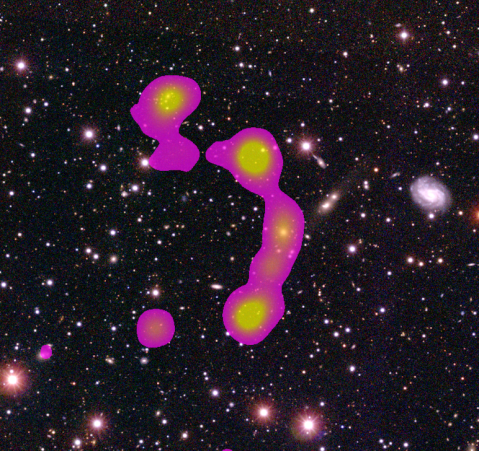Discovered galaxy cluster named after two citizen scientists
This post was written as a contribution by Timothy Friel, an undergraduate Australian National University student studying Theoretical Physics and Science Communication. Tim is conducting research into citizen science projects and their social media communication strategies.
Hats off to two of our volunteer participants who have officially been written in the stars.
The Matorny-Terentev Cluster RGZ-CL J0823.2+0333 bears the name of the two citizen scientists who pieced together its structure.
Ivan Terentev and Tim Matorny, two Radio Galaxy Zoo participants from Russia, discovered that a particular radio-source had a line of radio blobs delineating a C-shaped ‘Wide-Angle Tail galaxy’ (WAT). The massive galaxy hosting the super-massive black hole and its associated jets are moving through intergalactic gas, causing the jets to fold back, similar to the way a sky-diver’s hair is shaped by the wind.

Figure 1: The new discovery: The C-shaped “wide angle tail galaxy” (pink) surrounded by the galaxies of the Matorny-Terentev cluster (white). Julie Banfield, Author provided
This discovery has been published this week in the prestigious scientific journal Monthly Notices of the Royal Astronomical Society, with the paper “Radio Galaxy Zoo: discovery of a poor cluster through a giant wide-angle tail radio galaxy” (accessible for free via bit.ly/RGZpaperWAT).
Lead author of the study, Dr Julie Banfield of CAASTRO at The Australian National University (ANU), said that the discovery surprised the astronomers running the program.
“They found something that none of us had even thought would be possible”, said Dr Banfield.
More details of the research team’s response and the next steps for the project can be read in the press release published by CAASTRO (bit.ly/PR14June16).
A huge congratulations must go to the two citizen scientists, Ivan and Tim, for their efforts to work collaboratively to make this discovery. It is great to witness that physical and language barriers have been unable to halt amazing scientific endeavours.
A further thank you must also be noted for the Radio Galaxy Zoo team, in particular the joint project leaders Dr Julie Banfield (ANU) and Dr Ivy Wong (ICRAR at UWA), alongside Dr Anna Kapinska (ICRAR at UWA), Dr Ray Norris (CSIRO/WSU) and all other members of the international project. The team’s continued energy to motivate volunteer participants to develop their own research projects has uncovered the immense potential of citizen science as both a research tool and a method of bringing people together across the globe.
Finally, the Radio Galaxy Zoo team would like to thank the 10,000 volunteers globally who have volunteered to conduct over 1.6 million image classifications over the past two and a half years. The dedication of volunteers to this project has bred a supportive community which has now completed almost 60% of the dataset, a feat unable to be achieved by any single individual.
If you would love to become involved in this international astronomical community, please head to bit.ly/RadioGalaxyZoo1 and begin your journey to uncover the depths of our universe and its wonders, all from the comfort of your own home.
ANU: Australian National University
CAASTRO: Australian Research Council Centre of Excellence for All-Sky Astrophysics
CSIRO: Commonwealth Scientific and Industrial Research Organisation
ICRAR: International Centre for Radio Astronomy Research
UWA: University of Western Australia
